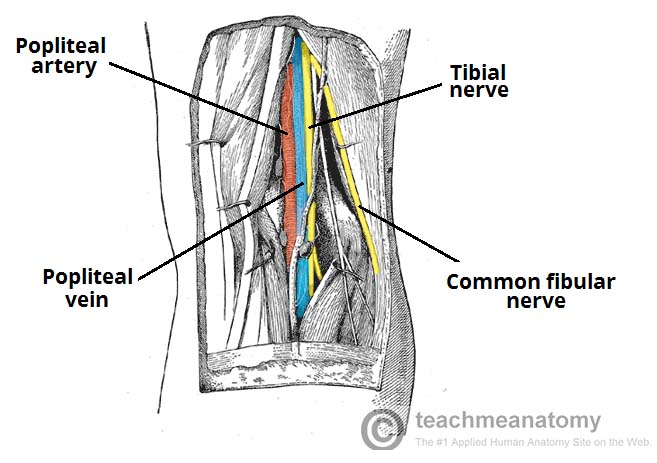Anatomical Areas in the Lower Limbs
The Femoral Triangle
The femoral triangle is a hollow area in the anterior thigh. Many large neurovascular structures pass through this area, and can be accessed relatively easily. Thus, it is an area of both anatomical and clinical importance.
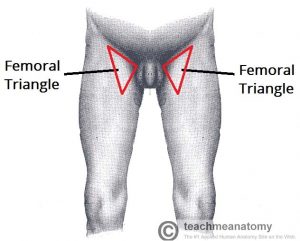
Borders
As this area is a triangle, it has three borders:
Superior border – Formed by the inguinal ligament, a ligament that runs from the anterior superior iliac spine to the pubic tubercle.
Lateral border – Formed by the medial border of the sartorius muscle.
Medial border – Formed by the medial border of the adductor longus muscle. The rest of this muscle forms part of the floor of the triangle.
Note: Some sources consider the lateral border of the adductor longus to be the medial border of the femoral triangle. However, the majority state that it is the medial border of the adductor longus – and this is definition we have gone with.
It also has a floor and a roof:
Anteriorly, the roof of the femoral triangle is formed by the fascia lata.
Posteriorly, the base of the femoral triangle is formed by the pectineus, iliopsoas and adductor longus muscles.
The inguinal ligament acts as a flexor retinaculum, supporting the contents of the femoral triangle during flexion at the hip.
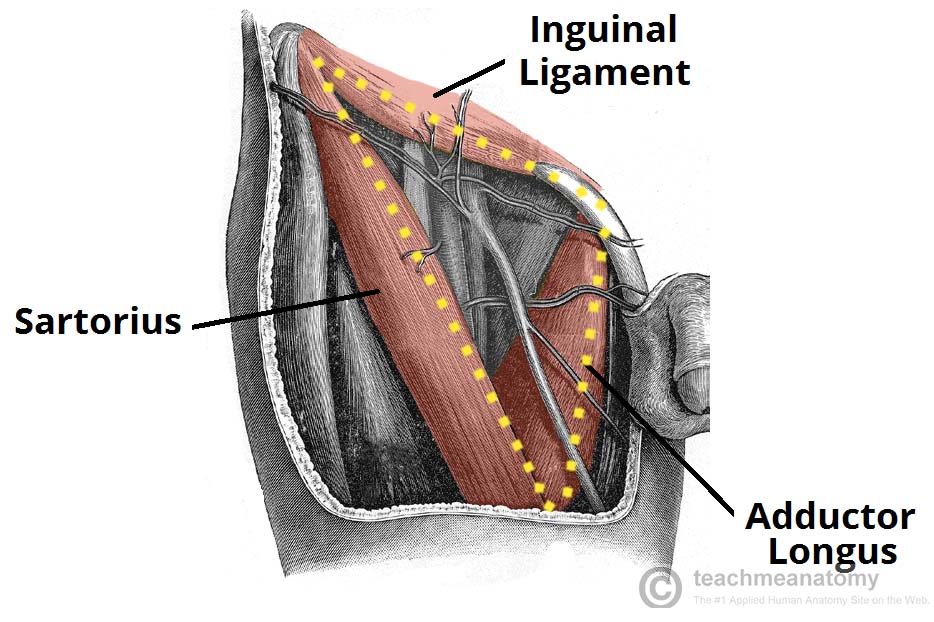
Contents
The femoral triangle contains some of the major neurovascular structures of the lower limb. Its contents (lateral to medial) are:
Femoral nerve – Innervates the anterior compartment of the thigh, and provides sensory branches for the leg and foot.
Femoral artery – Responsible for the majority of the arterial supply to the lower limb.
Femoral vein – The great saphenous vein drains into the femoral vein within the triangle.
Femoral canal – A structure which contains deep lymph nodes and vessels.
The femoral artery, vein and canal are contained within a fascial compartment – known as the femoral sheath.
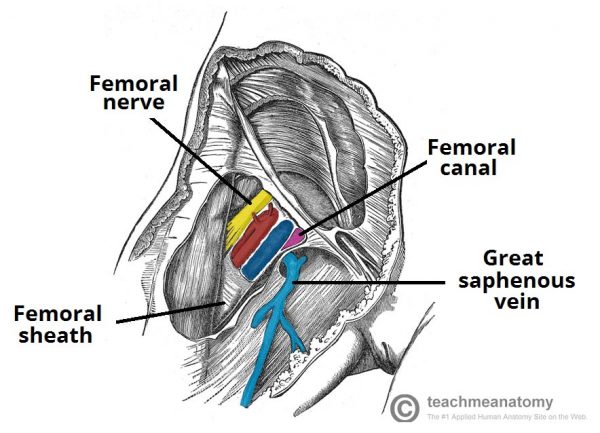
Acronyms
A good way of remembering the contents is using the acronym NAVEL:
N: Nerve.
A: Artery.
V: Vein.
E: Empty space (this is important as it allows the veins and lymph vessels to distend, so they can cope with different levels of flow).
L: Lymph canal.
The Femoral Canal
The femoral canal is an anatomical compartment located in the anterior thigh. It is the smallest and most medial part of the femoral sheath. It is approximately 1.3cm long.
Borders
The femoral canal is located in the anterior thigh within the femoral triangle.
It can be thought of as a rectangular shaped compartment with four borders and an opening:
Medial border – lacunar ligament.
Lateral border – femoral vein.
Anterior border – inguinal ligament.
Posterior border – pectineal ligament, superior ramus of the pubic bone, and the pectineus muscle
The opening to the femoral canal is located at its superior border, known as the femoral ring. The femoral ring is closed by a connective tissue layer – the femoral septum. This septum is pierced by the lymphatic vessels exiting the canal.
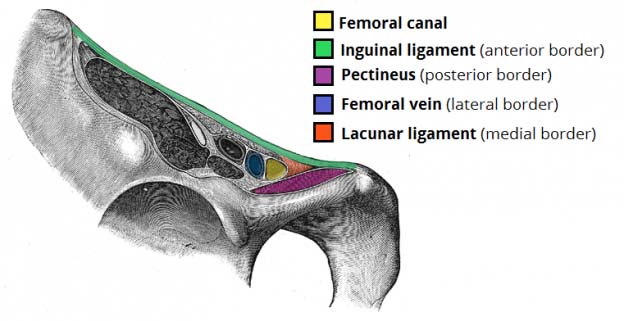
Contents
The femoral canal contains:
Lymphatic vessels – draining the deep inguinal lymph nodes.
Deep lymph node – the lacunar node.
Empty space.
Loose connective tissue.
The empty space allows distension of the adjacent femoral vein, so it can cope with increased venous return, or increased intra-abdominal pressure.
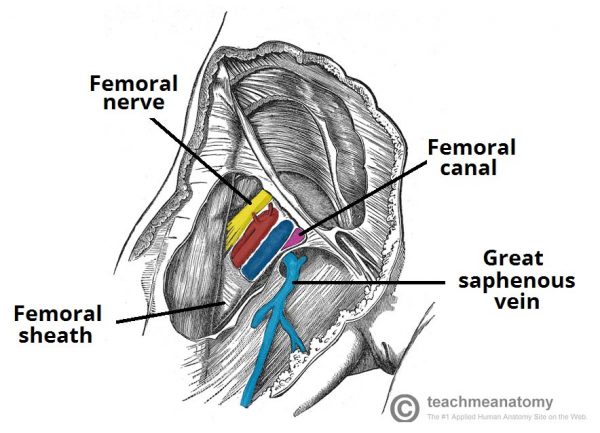
The Adductor Canal
The adductor canal (Hunter’s canal, subsartorial canal) is a narrow conical tunnel located in the thigh.
It is approximately 15cm long, extending from the apex of the femoral triangle to the adductor hiatus of the adductor magnus. The canal serves as a passageway from structures moving between the anterior thigh and posterior leg.
Borders
The adductor canal is bordered by muscular structures:
Anteromedial: Sartorius.
Lateral: Vastus medialis.
Posterior: Adductor longus and adductor magnus.
The adductor canal runs from the apex of the femoral triangle to the adductor hiatus – a gap between the adductor and hamstring attachments of the adductor magnus muscle.
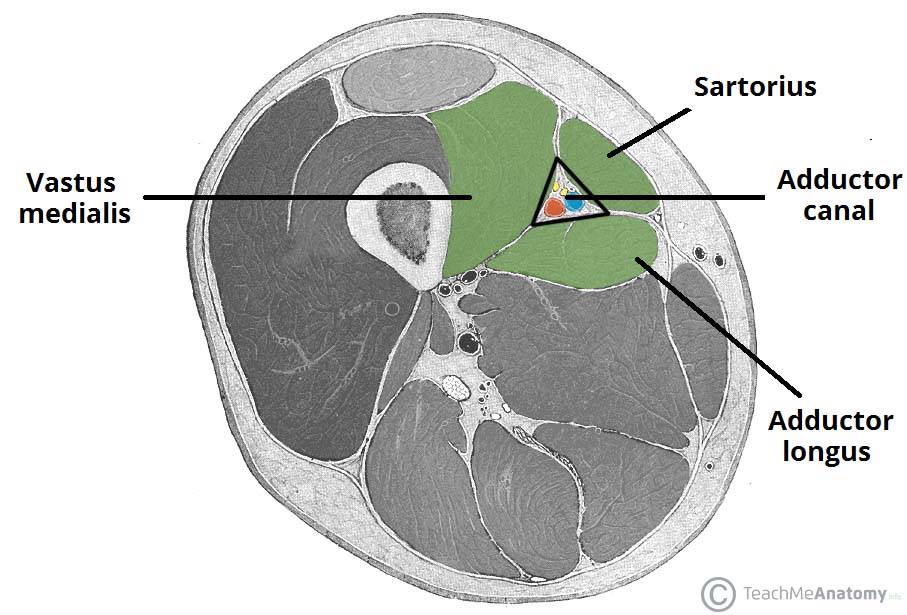
Contents
The adductor canal serves as a passageway for structures moving between the anterior thigh and posterior leg.
It transmits the femoral artery, femoral vein (posterior to the artery), nerve to the vastus medialis and the saphenous nerve – the largest cutaneous branch of the femoral nerve.
As the femoral artery and vein exit the canal, they are called the popliteal artery and vein respectively.
The Popliteal Fossa
The popliteal fossa is a diamond shaped area located on the posterior aspect of the knee. It is the main path by which vessels and nerves pass between the thigh and the leg.
Borders
The popliteal fossa is diamond shaped with four borders. These borders are formed by the muscles in the posterior compartment of the leg and thigh:
Superomedial border – semimembranosus.
Superolateral border – biceps femoris.
Inferomedial border – medial head of the gastrocnemius.
Inferolateral border – lateral head of the gastrocnemius and plantaris.
The popliteal fossa also has a floor and a roof. The floor is formed by the posterior surface of the knee joint capsule and by the posterior surface of the femur. The roof is made of up two layers; popliteal fascia and skin. The popliteal fascia is continuous with the fascia lata of the leg.
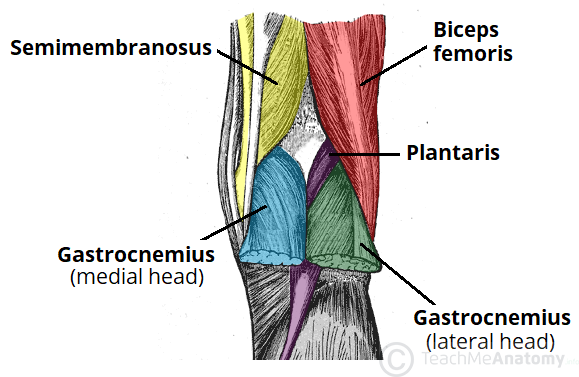
Contents
The popliteal fossa is the main conduit for neurovascular structures entering and leaving the leg. Its contents are (medial to lateral):
Popliteal artery
Popliteal vein
Tibial nerve
Common fibular nerve (common peroneal nerve)
The tibial and common fibular nerves are the most superficial of the contents of the popliteal fossa. They are both branches of the sciatic nerve. The common fibular nerve follows the biceps femoris tendon, travelling along the lateral margin of the popliteal fossa.
The small saphenous vein pierces the popliteal fascia of the popliteal fossa to enter the diamond, and empty into the popliteal vein.
In the popliteal fossa, the deepest structure is the popliteal artery. It is a continuation of the femoral artery, and travels into the leg to supply it with blood.
